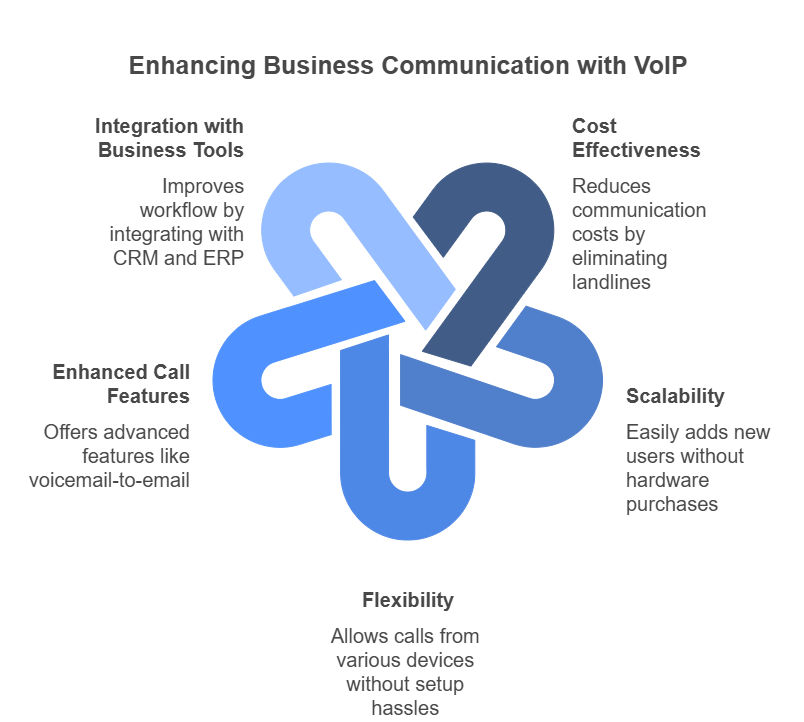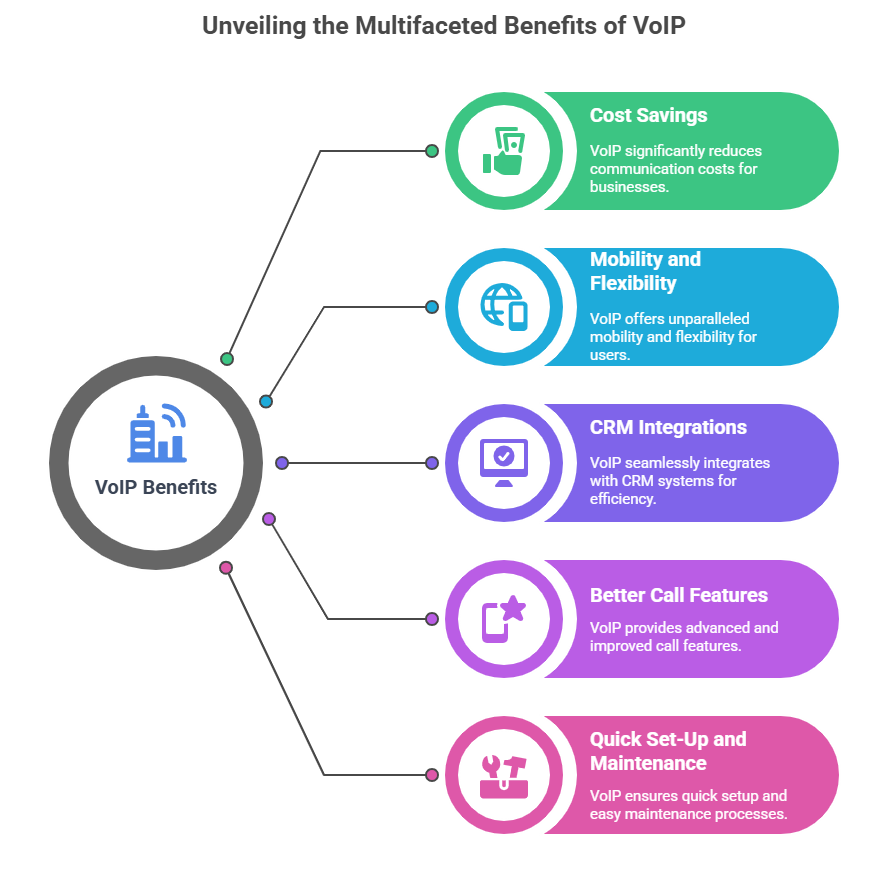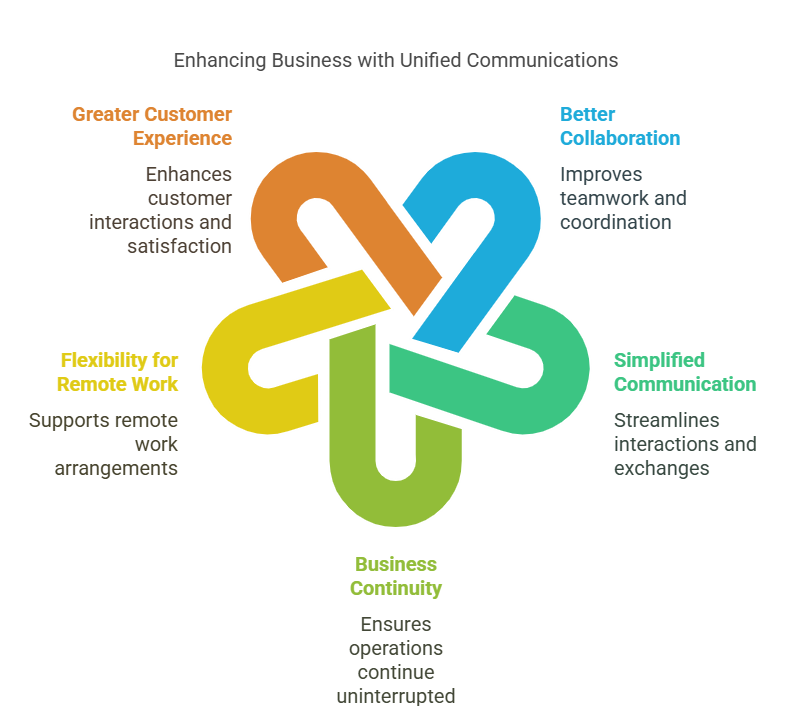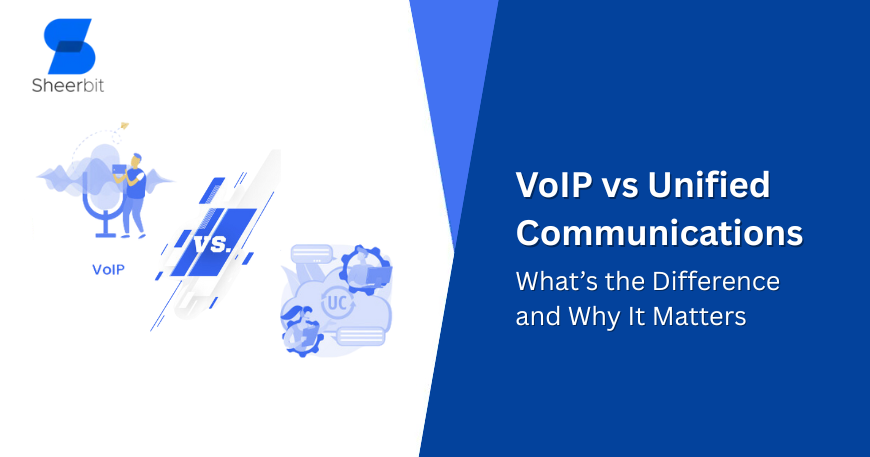Overview
VoIP technology allows for voice that travels over the internet, which is a more innovative system than a standard phone line. Unified Communications is a larger suite that allows for the integration of any voice, video, messaging, file sharing, and more. Understanding the difference is valuable to businesses that are investing in an upgraded communication ecosystem for their future.
Index
- Introduction
- What is VoIP?
- VoIP Technology Overview
- Benefits of VoIP
- What does UC mean?
- Components of UC
- Key Differences Between VoIP and UC
- Benefits of VoIP in Business
- Benefits of UC for Businesses
- So Which Should You Choose?
- How to Transition to VoIP or UC
- Security Aspects
- The Importance of Custom VoIP Development
- Conclusion
1. Introduction
As organizations have adopted more remote working, and technology has continued to evolve on how we digitally transform our work and become global organizations, companies are increasingly looking for ways to communicate effectively. Business Voice over IP (VoIP) and Unified Communication (UC) technologies are becoming increasingly embedded into an enterprise’s communications ecosystem. Companies have moved away from being tethered to the ground with a legacy telephone system.
Now the opportunity exists for enterprises to find improved ways of communicating, reduced costs, and better flexibility for employees.
This blog will look at VoIP and UC technologies, providing a comparison of both to help organizations decide which tools work best for them.
2. What is VoIP?
Voice over Internet Protocol (VoIP) refers to the ability to make voice calls over the internet instead of traditional telephone. VoIP takes the signal produced when someone speaks, digitizes it into packets of data, and sends over a connection of the internet. VoIP can also relieve companies of some of the costs associated with long-distance and international calls; since there are no physical telephone lines, it also allows for another cost-saving opportunity.
VoIP services can be offered by traditional and hosted VoIP service providers; some of which are hosted VoIP services that also use a cloud-based communication platform to provide VoIP services. VoIP can be used to conduct one-to-one calls, conference calls, and even video conferencing, depending on the provider and service requested.
3. VoIP Technology Overview
VoIP allows users to communicate via an internet connection sending voice data via packets of data. When a user makes a telephone call from a VoIP phone, the user’s voice will be digitized into packets of data. Then the data packets will transit across the internet to the device the caller intended and received them. When the data packets are received, they will be decoded at the other person’s device and converted back into sound.
VoIP systems implement specific protocols such as SIP (Session Initiation Protocol) and RTP (Real-time Transport Protocol) to ensure calls are routed and delivered in real time. In addition to making VoIP calls, many VoIP systems incorporate features like voicemail, call forwarding, call blocking, and usability with other applications, such as CRM platforms.
4. Benefits of VoIP
VoIP offers many advantages and features that enhance business communications. These include:

Cost Effective: VoIP removes the hardwired, expensive landline systems in the office, making costs significantly lower for communication, particularly for international calls.
Scalability: VoIP technology is a highly scalable system, therefore a great technology for businesses that are planning to grow. New users can be added easily with no purchase of additional hardware.
Flexibility: VoIP is typically cloud-based, allowing users to make calls from wireless phones, computers, or dedicated VoIP telephones. Users can utilize newer technology without the burden of extensive learning or setup.
Enhanced Call Features: Most VoIP systems contain capabilities typically not incorporated in older landline plans, such as voicemail-to-email, call forwarding, and automated attendants, which make services related to customer service and internal business communications easier, and often more personal;
Combined with Other Tools: VoIP is ideal for integration within business tools such as CRM, ERP, and marketing tools, improving overall workflow and quality.
5. What does UC mean?
Unified Communications (UC) is the next evolution in communications, as it integratesUC includes VoIP or voice over IP, not just voice but other tools such as video conferencing, instant messaging, file sharing, etc., in a seamless interface. UC hopes to streamline communication and collaboration by removing barriers that exist between tools and channels.
Within UC, businesses can collaborate no matter which communication medium is being used (text, voice, and video) without constantly switching between tools and applications.
6. Components of UC
A fully integrated system of UC usually contains several components:
VoIP: Voice calls over IP are the main feature of most UC systems.
Instant messaging and presence. Real-time text communication with presence indicators of contact availability, busy, or offline.
Email: Email integration is a common feature in UC and provides an easy way for us to access all our communication in one place.
Video conferencing: Video communication applications like Zoom, Microsoft Teams, or Skype.
Collaboration: Team collaborations, such as file sharing, document collaboration, and shared task management, are examples of collaboration within UC platforms.
Mobile: UC systems have access for mobile phones and tablets to allow communication for all employees on the move.
7. Key Differences Between VoIP and UC
is a critical component of UC, the two technologies differ in terms of functionality, integration, and purpose. Here’s a closer look at their key differences:
| Feature | VoIP | Unified Communications |
|---|---|---|
| Core Functionality | Voice communication over the internet | Integration of voice, video, messaging, and collaboration |
| Integration | Limited to voice calls | Multiple communication tools in one system |
| Collaboration Features | Focuses on voice communication | Includes messaging, file sharing, video conferencing, etc. |
| User Experience | Basic voice calling | Unified, seamless experience across devices |
| Scalability | High scalability for voice | Scalable across all communication channels |
| Deployment Complexity | Simple and cost-effective setup | Complex setup with integration across multiple tools |
| Ideal For | Cost-conscious businesses | Collaboration-focused enterprises or remote teams |
8. Benefits of VoIP in Business
Overall VoIP systems offer a number of benefits to businesses relying on traditional phone systems. Some of the key benefits of VoIP include:

Cost Savings: VoIP can help reduce operational costs to businesses by eliminating traditional phone lines and lowering long-distance call costs.
Mobility and Flexibility: VoIP lets employees make and receive calls from anywhere where they can access an internet connection, providing additional flexibility, and helping facilitate remote working.
CRM Integrations: VoIP systems can be integrated into CRM tools, enabling companies to track customer interactions which enhances focus on customer service.
Better Call Features: Updated communications tools reduce the ‘friction’ of business communication by making things like call forward, call hold and voicemail-to-email, easy to manage.
Quick Set-Up and Maintenance: VoIP systems are no-hassle and less complicated than traditional phone systems. VoIP requires little to no hardware and can be set-up quickly. Maintenance is managed in the cloud, which results in less downtime and fewer interruptions.
9. Benefits of UC for Businesses
UC combines multiple tools and technologies to enhance the collaboration and communication experience. The benefits of UC are:

Better Collaboration: Teams can collaborate via multiple channels, including video, voice, instant messaging, and sharing files, in a single platform have been shown to enhance productivity.
Simplified Communication: By having all communication in one platform, users do not need to switch between multiple applications, which leads to an easier and faster communication process.
Business Continuity: And since UC platforms are typically cloud-based, communication systems will remain functional despite service interruptions or network conditions.
Flexibility for Remote Work: UC provides seamless communication for remote teams with video conferencing, instant messaging and file sharing capabilities, available from any device.
Greater Customer Experience: By embracing UC and supporting omnichannel communication, businesses can create a consistent customer service experience for all channels in a quicker amount of time than ever before.
10. So Which Should You Choose?
The choice between VoIP and UC meets the needs of a company. Consider the following when determining which is best for you:
– Choose VoIP if:
– You’re looking for a cost-effective voice call solution.
– You’re looking to find a replacement for your traditional phone system that isn’t complicated, that is scalable and cost effective..
– You’re simply looking for a voice communication solution
– Choose UC if:
– You’re looking for an all-in-one communications solution with collaboration capabilities across multiple modes (voice, video, messaging).
– You’re a remote workforce needing team collaboration communication.
– You’re looking for seamless integration into ONE platform for productivity.
11. How to Transition to VoIP or UC
Transitioning to VoIP or UC should not be difficult if you plan ahead:
- Evaluate Your Communication Needs: You need to know what features you will require – simple voice communication or more robust tools such as messaging and video conferencing.
- Choose Your Provider: Will you pick a VoIP Development Company or UC Service Provider? Align with your business requirements but must be mindful of your budget.
- Organize the Migration: Put the necessary planning and infrastructure into place and ensure your staff are in tune for success.
- Observe the Use of the System: Continuously observe the use of the system and optimize based on your users’ experience.
12. Security Aspects
Both VoIP and UC require business continuity and security to protect your data forms. Consider the following:
Encryption: Use TLS and SRTP to encrypt the transport of data
Firewall: Firewalls and Intrusion Detection Systems to protect your communication from external threats
Format: Secure communication protocols such as SIP for VoIP and secure login for UC.
Expire: Keep all software and hardware updated with the latest security patch.
13. The Importance of Custom VoIP Development
The necessity of custom VoIP development As a business model reliance continues to grow to develop scalable, industry-specific solutions for business. It is important to work with a VoIP Developer experienced in VoIP and UC development. Custom VoIP development solutions allow businesses to:
– Integrate VoIP with other organizational systems such as assets CRM, ERP, etc.
– Offer unique, tailored features required by an industry-based situation (e.g., healthcare, finance, education)
– Scale easily understands changing business requirements for communications solutions.
Conclusion
In conclusion, VoIP (Voice over Internet Protocol) and Unified Communication (UC) have provided the enablers to modernize business communications. VoIP is a simple, cost effective solution focused on voice which makes it a great solution for businesses reducing telephone costs and flexibility in communications.
The UC solution consists of all the elements of VoIP but is more comprehensive because it combines multiple communications tools that include voice, video, messaging, and collaboration as a single solution. UC is a better fit for businesses that are leveraging an integrated communication system that supports workflows among distributed teams, while allowing for increased collaboration and productivity.
Ultimately, the decision to select VoIP or UC will depend on your business needs:
– If you are a business that requires a simple, low cost voice communication option, then VoIP makes sure to be the best option.
– If your organization requires a complete communication and collaboration suite to support a distributed workforce, the UC suite will provide the mix of communication that will allow the workforce to remain connected and work productively.
So whether you choose VoIP or UC as your next solution, you will be investing in a modern communication solution that supports your business operations more efficiently, enhances the overall customer experience, or supports increased flexibility within your business.
Knowing the key benefits each option provides enables businesses to take a more considered decision as to which solution aligns better with their strategic goals and communications needs. Therefore, whether you choose to implement VoIP as a standalone solution or as a part of a full Unified Communications system, changing your organization’s communication streaming platforms to modern solutions will help your organization to scale and succeed in a rapidly changing digital ecosystem.
Are you ready to upgrade your business communications? If you’re ready to implement VoIP for more cost-effective voice solutions, or you want to do Unified Communications for true collaboration across many different channels, we can help.
At Sheerbit, we specialize in both custom VoIP development and Unified Communications solutions. Our team of experts will help you pick and deploy the right solution to meet your unique business needs, as well integrate it with other communications systems and ensure proper continuity, security, and scalability.
Contact us today and we will set up a consultation to unlock your communications landscape!
FAQs
1. What is the main difference between VoIP and Unified Communications?
VoIP is primarily focused on voice communication over the internet, while Unified Communications integrates voice, video, messaging, and collaboration tools into a single platform.
2. Can VoIP be used with Unified Communications?
Yes, VoIP is a core component of most Unified Communications platforms. UC systems use VoIP for voice communication, but also offer additional tools like video conferencing, instant messaging, and file sharing.
3. What are the benefits of using VoIP for my business?
VoIP offers cost savings on phone calls, scalability, flexibility for remote work, and advanced features like voicemail-to-email and call forwarding.
4. When should I choose VoIP over Unified Communications?
Choose VoIP if your business primarily needs a cost-effective voice communication solution, with minimal collaboration features.
5. What is included in a Unified Communications system?
A UC system typically includes VoIP, instant messaging, video conferencing, email integration, file sharing, and team collaboration tools.
6. Is Unified Communications suitable for small businesses?
Yes, UC can be beneficial for small businesses, especially those with remote teams or a need for integrated communication tools across channels.
7. What are the security concerns with VoIP and UC?
Security concerns for both VoIP and UC include call interception, data breaches, and unauthorized access. Using encryption, firewalls, and secure protocols is essential.
8. Can I scale VoIP or Unified Communications as my business grows?
Yes, both VoIP and UC systems are highly scalable. VoIP allows businesses to add new users easily, while UC platforms can grow to accommodate more communication tools and users.
9. How do VoIP and UC impact remote work?
Both solutions are ideal for remote work. VoIP allows employees to make and receive calls from anywhere, while UC integrates communication tools that enable seamless collaboration across teams.
10. What is the cost difference between VoIP and Unified Communications?
VoIP is typically more affordable, focusing on voice communication, while Unified Communications systems can be more expensive due to the additional collaboration tools and integrations.




